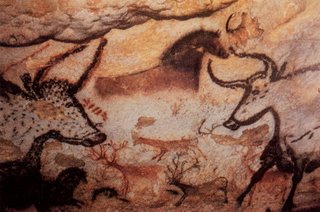World History
 Were cave artists sex- and hunting-obsessed teenage boys?
Were cave artists sex- and hunting-obsessed teenage boys?
I discovered an article with the title "Paleolithic Juvenilia" in the August 2006 issue of Scientific American. It was written by JR Minkel and it covers the research of R. Dale Guthrie, a paleobiologist emeritus at the University of Alaska-Fairbanks.
Dr. Guthrie argues that Paleolithic cave art differs greatly from art created for ritualistic or shamanic purposes. "Paleolithic art isn't like that," he said. "It was done in a more naturalistic way, [showing] real animals eating, copulating, braying or bellowing, biting."
Guthrie studied 201 handprints found in caves from Spain and France. He measured them and compared them to modern humans. Statistically, the cave handprints match children ages 10 to 16. Much of the cave drawings focus on hunting and mating as well. As these are well know activities that have fascinated adolescent males in the past, it is reasonable to assume they are the ones most likely to have created the cave art.
Clearly, the Paleolithic cave drawings today are world treasures. They have taught us a lot about the world our ancestors lived in as well as teaching us about our ancestors as well. And to think we may have hormonally driven boys to thank for it...
- Jomon Japan
Jomon Japan. This site has a practical introduction to Jomon archaeology in Japan. It includes museums, links to other related sites, and research literature. The site describes this ancient Japanese period. It notes, "The Jomon period, from approx....
- Last Stand Of The Neanderthals?
Neanderthals survived longer than thought. This article is from today's issue of USA Today. Research suggests Neanderthals survived for thousands of years longer than thought, with small bands finding refuge in a massive cave in Spain. They used the...
- Pages Through The Ages
Pages through the Ages. Created by 5th-graders at Oak View Elementary School in Fairfax, Virginia, this site explores the geography, government, daily life, religion and technology of ancient Egypt, Greece and Rome. From the site: The prehistoric era...
- Virtual Field Trips
I have done some work recently with SmarterSchools.comhttp://smarterschoolsproject.com/ and their contact recently asked me if I had done any virtual field trips with my students. Well yes. If you Google them, you can find lots of them. For...
- Cave Art
This is a very interesting article that you might add to when you talk about cave art at the beginning of your World History I course. What is most interesting is that it is about cave art found in Indonesia that is at least 39,000 years old and...
World History
Paleolithic Juvenilia
 Were cave artists sex- and hunting-obsessed teenage boys?
Were cave artists sex- and hunting-obsessed teenage boys?I discovered an article with the title "Paleolithic Juvenilia" in the August 2006 issue of Scientific American. It was written by JR Minkel and it covers the research of R. Dale Guthrie, a paleobiologist emeritus at the University of Alaska-Fairbanks.
Dr. Guthrie argues that Paleolithic cave art differs greatly from art created for ritualistic or shamanic purposes. "Paleolithic art isn't like that," he said. "It was done in a more naturalistic way, [showing] real animals eating, copulating, braying or bellowing, biting."
Guthrie studied 201 handprints found in caves from Spain and France. He measured them and compared them to modern humans. Statistically, the cave handprints match children ages 10 to 16. Much of the cave drawings focus on hunting and mating as well. As these are well know activities that have fascinated adolescent males in the past, it is reasonable to assume they are the ones most likely to have created the cave art.
Clearly, the Paleolithic cave drawings today are world treasures. They have taught us a lot about the world our ancestors lived in as well as teaching us about our ancestors as well. And to think we may have hormonally driven boys to thank for it...
- Jomon Japan
Jomon Japan. This site has a practical introduction to Jomon archaeology in Japan. It includes museums, links to other related sites, and research literature. The site describes this ancient Japanese period. It notes, "The Jomon period, from approx....
- Last Stand Of The Neanderthals?
Neanderthals survived longer than thought. This article is from today's issue of USA Today. Research suggests Neanderthals survived for thousands of years longer than thought, with small bands finding refuge in a massive cave in Spain. They used the...
- Pages Through The Ages
Pages through the Ages. Created by 5th-graders at Oak View Elementary School in Fairfax, Virginia, this site explores the geography, government, daily life, religion and technology of ancient Egypt, Greece and Rome. From the site: The prehistoric era...
- Virtual Field Trips
I have done some work recently with SmarterSchools.comhttp://smarterschoolsproject.com/ and their contact recently asked me if I had done any virtual field trips with my students. Well yes. If you Google them, you can find lots of them. For...
- Cave Art
This is a very interesting article that you might add to when you talk about cave art at the beginning of your World History I course. What is most interesting is that it is about cave art found in Indonesia that is at least 39,000 years old and...
